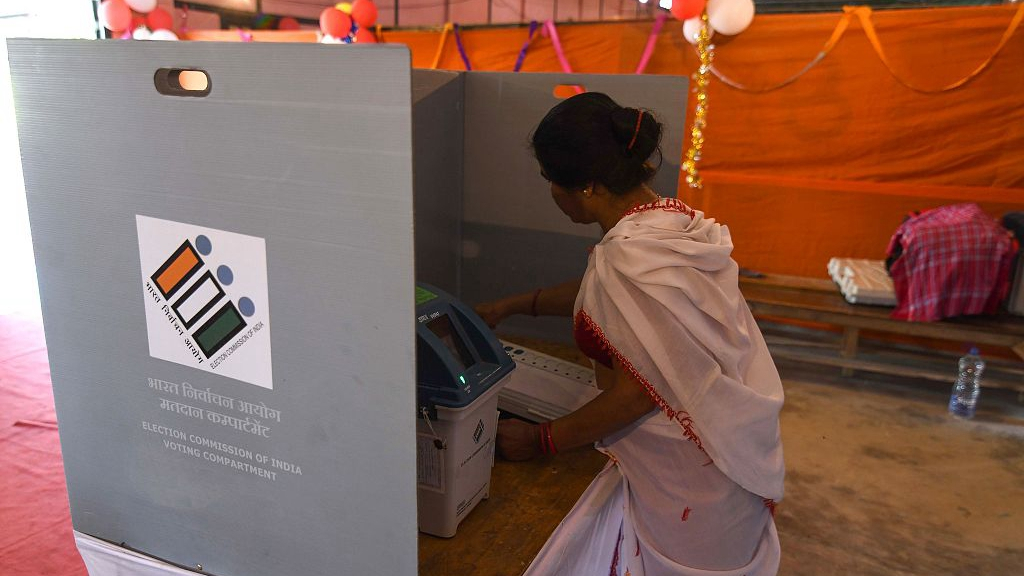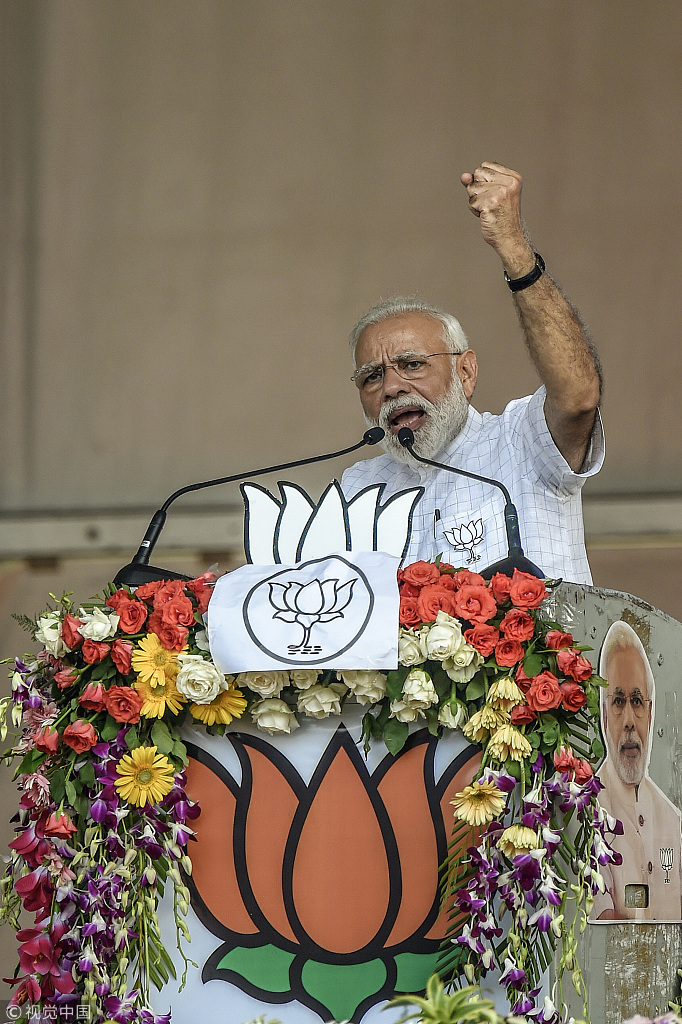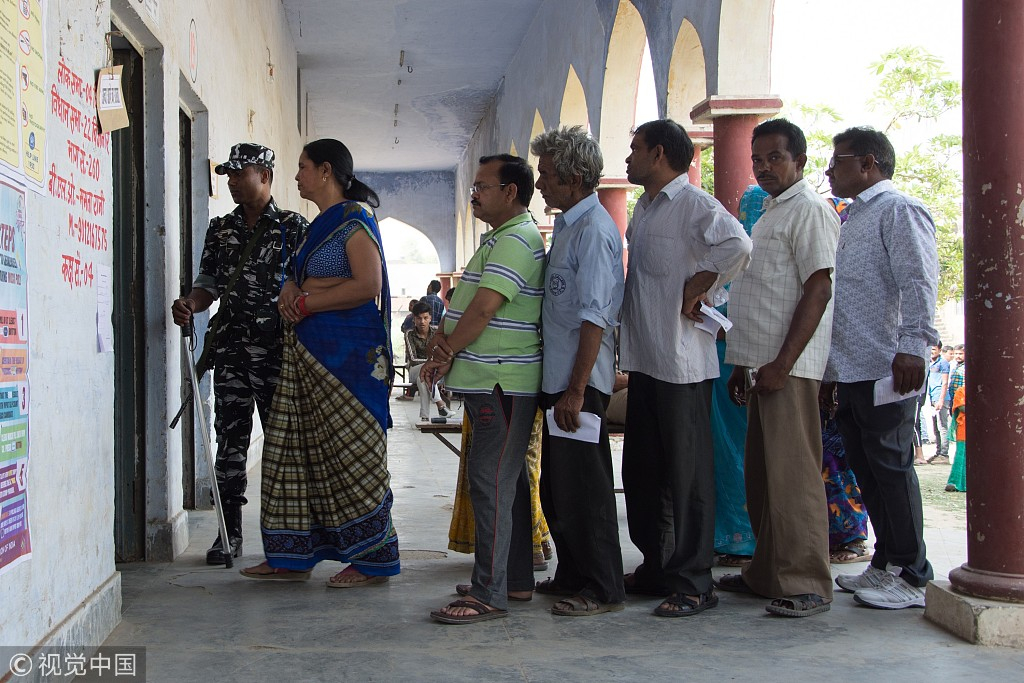
Opinion
20:29, 11-Apr-2019
Indian parliamentary election officially unveiled
Wang Shida

Editor's note: Wang Shida is the associate research fellow at the Institute of South Asian Studies, China Institutes of Contemporary International Relations. The article reflects the author's opinion, and not necessarily the views of CGTN.
From April 11 to May 19 this year, India is holding a new round of parliamentary elections. Parties like Bharatiya Janata Party (BJP) and the Congress Party will compete for the next government.
It seems that most people believe BJP who won the first single-party majority in the past 30 years in the country's lower house of parliament in 2014 may get reelected. After assuming office, the Modi government has adopted a series of reform measures, such as the implementation of the Goods and Services Tax (GST) to establish a national unified domestic market, as well as improving the Indian business environment by relaxing foreign investment in India.

Indian Prime Minister Narendra Modi speaks at the public rally at Brigade ground in Kolkatta, India, April 3, 2019. /VCG Photo
Indian Prime Minister Narendra Modi speaks at the public rally at Brigade ground in Kolkatta, India, April 3, 2019. /VCG Photo
Under Modi's leadership, India has maintained a growth rate of more than seven percent for several years and has become the fastest growing economy among the major economies. At the same time, Modi has also led the BJP to win frequently in local elections since 2014, and has obtained the power of many key states, either alone or in conjunction with other political parties, such as Uttar Pradesh, which has a population of more than 200 million. BJP controlled 21 of India's 28 state-level assemblies by May 2018.
However, doubt remains as to whether the BJP will win the re-election. From the perspective of the economy, although the Modi government has led India to achieve rapid economic growth, there are still problems.
For example, two policies the Modi government took in the name of reform resulted in economic distress. The first was demonetization in November 2016, which was termed as an anti-corruption measure. Under that policy, almost 90 percent of the country's currency is unable to fit into ATMs, leading to recalibration delays which deepened the shock and caused economic activity in the informal, cash-based economy.
Besides, GST, which means to unify all of India's states into a single market had a rocky and complicated debut that hurt some businesses as well. In a word, the election has become tighter because of discontent in the countryside over a weak rural economy and lack of jobs for young people. From the perspective of politics, during the latest round of local elections held in late 2018, the BJP did not win a single state, including the populous state of Madhya Pradesh.
Interestingly, the India-Pakistan relationship also has an important impact on the ongoing general election. In February 2019, India-controlled Kashmir suffered a cross-border terrorist attack. The Indian authorities accused the Jaish-e-Mohammad (JeM) group which based in Pakistan of being behind the scenes and launched a large-scale air strike against Pakistan. The Pakistan Air Force responded the next day and shot down at least one Indian fighter.

Indians cast their vote for the first phase of general election in Bijnor district of Uttar Pradesh, India, April 11, 2019. /VCG Photo
Indians cast their vote for the first phase of general election in Bijnor district of Uttar Pradesh, India, April 11, 2019. /VCG Photo
According to polls, before the India-Pakistan conflict, Indian voters were most concerned about economic development, employment opportunities, and agricultural issues. After the conflict, their attention has shifted to dealing with Pakistan, as well as other national security issues.
Furthermore, the polling support of BJP rose after the conflict. The poll showed that 43 percent of respondents wanted Modi as the next prime minister, with 24 percent for Congress leader Rahul Gandhi.
Whether BJP or Congress Party wins the election, the new government will face similar challenges. From the perspective of the economy, the recent trade friction between India and the United States has shown signs of rising. The Trump administration emphasizes "America First." In terms of economic and trade, whether it is with strategic opponents, or allies or partners, Trump insists that the U.S. should get more benefit.
For example, the Trump administration has already increased tariffs on steel and aluminum products from India and reduced the number of Indian products that enjoy U.S. GSP treatment. India has repeatedly assessed retaliatory tariffs on 29 categories of U.S. goods, and more recently it has introduced a series of new regulations for e-commerce operations which led to serious dissatisfaction like the U.S. e-commerce giant Amazon.
The Office of the U.S. Trade Representative is assessing the full cancellation of the U.S. GSP treatment enjoyed by India, which will have a serious negative impact on the six billion U.S. dollars' worth of Indian exporst to the U.S. From the perspective of diplomacy, India needs to better handle the relations with Pakistan. In recent years, India's economy has developed rapidly, and its comprehensive national strength has continued to improve. Its strategic goal has changed to play a greater role in the global political arena, and war or conflict with Pakistan will inevitably affect the Indian Dream.
(If you want to contribute and have specific expertise, please contact us at opinions@cgtn.com.)

SITEMAP
Copyright © 2018 CGTN. Beijing ICP prepared NO.16065310-3
Copyright © 2018 CGTN. Beijing ICP prepared NO.16065310-3